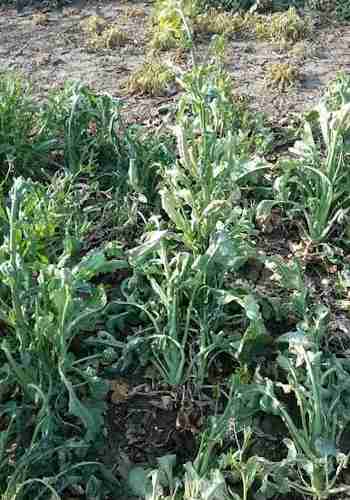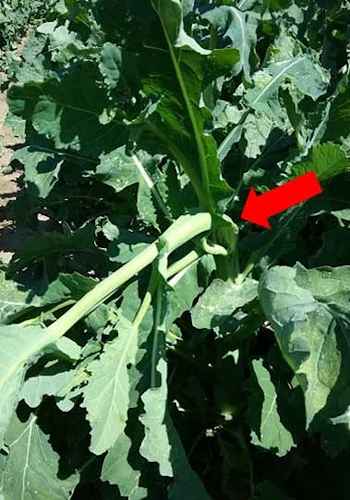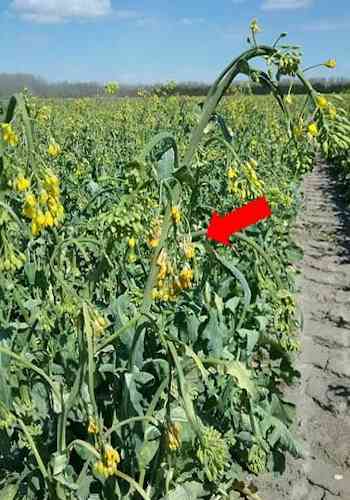- One observation is that canola varieties with weakened stems were severely impacted by the recent freezes (Figure 2). Initially, these plants were physically damaged (cracked) by fluctuating winter temperatures, which allows fungi to enter the plant, causing decay of vascular tissues. We often call this winter decline syndrome. The freezes are impacting these plants more because there is insufficient vascular tissue for normal plant development.

Figure 2. This variety is extremely susceptible to winterkill and winter decline syndrome, and is showing severe effects from the spring freezes. Photo by Mike Stamm, K-State Research and Extension.
- At the bolting stage, some discoloration will be evident on leaf or stem tissues. The main stem and flower buds may turn pale green or purple, which is a symptom of cold temperatures and does not necessarily indicate tissue damage. Again, if stem and leaf tissues eventually turn brown and flowering does not follow, then damage was likely severe and a yield reduction can be expected.
- Cracking or stem splitting may be observed. If the stem only cracks, then the canola plant should continue to grow normally. Splitting (Figure 3) occurs when the stem fills up with ice and ruptures. If the stem splits completely open, a major entry point for fungal decay now exists. Also, the weakened stem may result in the plant eventually falling over. Some plants with translucent, mushy stems were observed the morning of April 14. It is too early to determine if this was severe enough to cause a reduction in yield potential. Stem splitting was not a widespread problem in the canola plots near Manhattan.

Figure 3. Stem splitting can occur after spring freeze events. This becomes an entry point for fungi and future stem decay. Photo by Mike Stamm, K-State Research and Extension.
- At the flowering stage, we often see bleaching of leaves and a bend or crook in the stem and flowering racemes. Often, these bends may take the flowering racemes to the ground; however, we have seen plants straighten and continue flowering normally. The only problem may be the racemes set seed below the main canopy of pods, potentially creating problems at harvest.
- Unopened buds should produce flowers and growing pods should produce viable seed. After any freeze event, blank areas will likely be observed on flowering racemes. In severe cases, we have seen the main raceme and some secondary branches completely freeze off and die (Figure 4). The crop can compensate for the losses with secondary branching.

Figure 4. Flowering racemes are bent over following freeze events near Manhattan, KS. The red arrow is pointing to a wilted flower cluster that will likely dry up. Photo by Mike Stamm, K-State Research and Extension.
- Genotypic differences in tolerance to spring freezes exist (Fig. 5). Plants having later flowering are typically able to overcome spring freeze events because they are in a more tolerant plant growth stage, i.e., bolting. Axillary buds are still being developed. Earlier flowering varieties are more susceptible because they may be too far along to develop any new flowering clusters. Generally, varieties with greater winter hardiness and tolerance to winter decline syndrome are also more tolerant to spring freezes. This is because their vascular tissues have not been compromised before the freeze events occurred.

Figure 5. Canola varieties with greater winter hardiness, tolerance to winter decline syndrome, and later maturity tend to see less negative effects from spring freezes. This particular variety, KS4719, is a potential new release from the canola breeding program.
Longer durations of temperatures in the mid-20s may increase the severity of damage. The extent of damage and potential yield loss relative to how long it stays this cold is somewhat of an unknown. But as long as the plants show normal growth in the upcoming days and weeks, reasonable yields can be expected.
Long-term impact of freeze damage
Longer term effects on the crop include differential maturity, delayed maturity, and reduced plant height. Differential maturity may occur if the freeze wasn’t quite severe enough to completely kill the plant, and favorable conditions cause a secondary bloom to occur. Delayed crop maturity results in flowering and grain filling during a warmer period which can reduce yield if temperatures are above 90. If temperatures remain cool during flowering and early grain fill, yield reductions should be minimized. Reduced plant height doesn’t necessarily result in reduced yield.
The indeterminate growth habit still gives canola an opportunity to compensate for lost yield. How well the crop yields will be a function of the weather over the next few weeks.
Source : ksu.edu